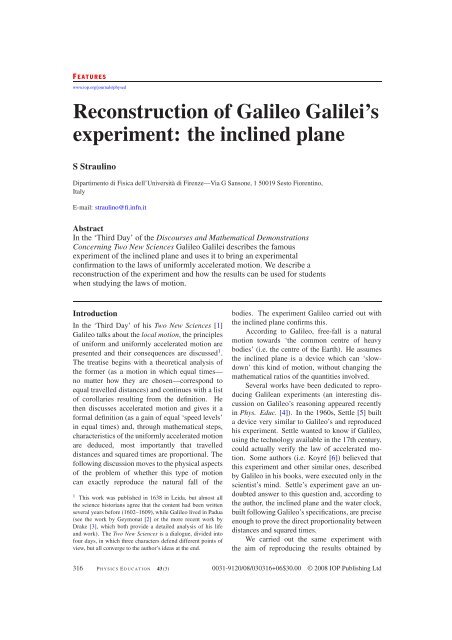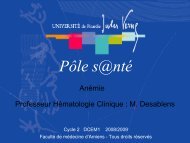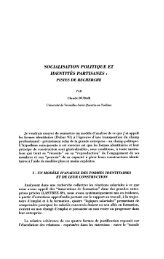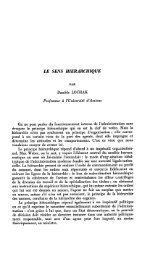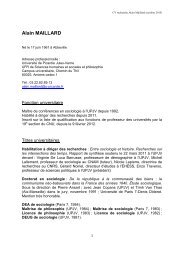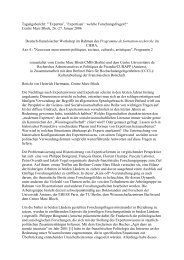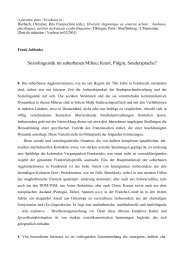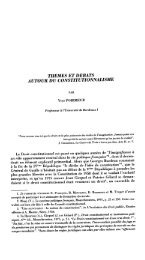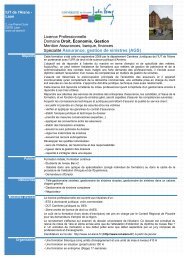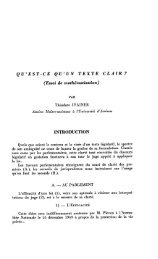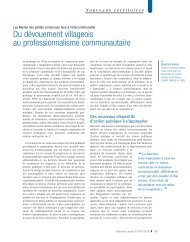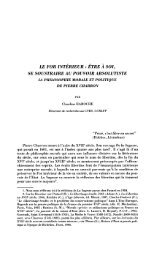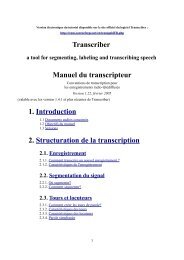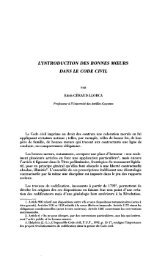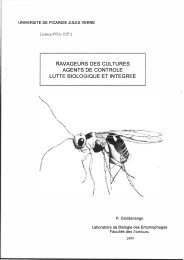Reconstruction of Galileo Galilei's experiment: the inclined plane
Reconstruction of Galileo Galilei's experiment: the inclined plane
Reconstruction of Galileo Galilei's experiment: the inclined plane
Create successful ePaper yourself
Turn your PDF publications into a flip-book with our unique Google optimized e-Paper software.
F EATURES<br />
www.iop.org/journals/physed<br />
<strong>Reconstruction</strong> <strong>of</strong> <strong>Galileo</strong> Galilei’s<br />
<strong>experiment</strong>: <strong>the</strong> <strong>inclined</strong> <strong>plane</strong><br />
S Straulino<br />
Dipartimento di Fisica dell’Università di Firenze—Via G Sansone, 1 50019 Sesto Fiorentino,<br />
Italy<br />
E-mail: straulino@fi.infn.it<br />
Abstract<br />
In <strong>the</strong> ‘Third Day’ <strong>of</strong> <strong>the</strong> Discourses and Ma<strong>the</strong>matical Demonstrations<br />
Concerning Two New Sciences <strong>Galileo</strong> Galilei describes <strong>the</strong> famous<br />
<strong>experiment</strong> <strong>of</strong> <strong>the</strong> <strong>inclined</strong> <strong>plane</strong> and uses it to bring an <strong>experiment</strong>al<br />
confirmation to <strong>the</strong> laws <strong>of</strong> uniformly accelerated motion. We describe a<br />
reconstruction <strong>of</strong> <strong>the</strong> <strong>experiment</strong> and how <strong>the</strong> results can be used for students<br />
when studying <strong>the</strong> laws <strong>of</strong> motion.<br />
Introduction<br />
In <strong>the</strong> ‘Third Day’ <strong>of</strong> his Two New Sciences [1]<br />
<strong>Galileo</strong> talks about <strong>the</strong> local motion, <strong>the</strong> principles<br />
<strong>of</strong> uniform and uniformly accelerated motion are<br />
presented and <strong>the</strong>ir consequences are discussed1 .<br />
The treatise begins with a <strong>the</strong>oretical analysis <strong>of</strong><br />
<strong>the</strong> former (as a motion in which equal times—<br />
no matter how <strong>the</strong>y are chosen—correspond to<br />
equal travelled distances) and continues with a list<br />
<strong>of</strong> corollaries resulting from <strong>the</strong> definition. He<br />
<strong>the</strong>n discusses accelerated motion and gives it a<br />
formal definition (as a gain <strong>of</strong> equal ‘speed levels’<br />
in equal times) and, through ma<strong>the</strong>matical steps,<br />
characteristics <strong>of</strong> <strong>the</strong> uniformly accelerated motion<br />
are deduced, most importantly that travelled<br />
distances and squared times are proportional. The<br />
following discussion moves to <strong>the</strong> physical aspects<br />
<strong>of</strong> <strong>the</strong> problem <strong>of</strong> whe<strong>the</strong>r this type <strong>of</strong> motion<br />
can exactly reproduce <strong>the</strong> natural fall <strong>of</strong> <strong>the</strong><br />
1 This work was published in 1638 in Leida, but almost all<br />
<strong>the</strong> science historians agree that <strong>the</strong> content had been written<br />
several years before (1602–1609), while <strong>Galileo</strong> lived in Padua<br />
(see <strong>the</strong> work by Geymonat [2] or <strong>the</strong> more recent work by<br />
Drake [3], which both provide a detailed analysis <strong>of</strong> his life<br />
and work). The Two New Sciences is a dialogue, divided into<br />
four days, in which three characters defend different points <strong>of</strong><br />
view, but all converge to <strong>the</strong> author’s ideas at <strong>the</strong> end.<br />
bodies. The <strong>experiment</strong> <strong>Galileo</strong> carried out with<br />
<strong>the</strong> <strong>inclined</strong> <strong>plane</strong> confirms this.<br />
According to <strong>Galileo</strong>, free-fall is a natural<br />
motion towards ‘<strong>the</strong> common centre <strong>of</strong> heavy<br />
bodies’ (i.e. <strong>the</strong> centre <strong>of</strong> <strong>the</strong> Earth). He assumes<br />
<strong>the</strong> <strong>inclined</strong> <strong>plane</strong> is a device which can ‘slowdown’<br />
this kind <strong>of</strong> motion, without changing <strong>the</strong><br />
ma<strong>the</strong>matical ratios <strong>of</strong> <strong>the</strong> quantities involved.<br />
Several works have been dedicated to reproducing<br />
Galilean <strong>experiment</strong>s (an interesting discussion<br />
on <strong>Galileo</strong>’s reasoning appeared recently<br />
in Phys. Educ. [4]). In <strong>the</strong> 1960s, Settle [5] built<br />
a device very similar to <strong>Galileo</strong>’s and reproduced<br />
his <strong>experiment</strong>. Settle wanted to know if <strong>Galileo</strong>,<br />
using <strong>the</strong> technology available in <strong>the</strong> 17th century,<br />
could actually verify <strong>the</strong> law <strong>of</strong> accelerated motion.<br />
Some authors (i.e. Koyré [6]) believed that<br />
this <strong>experiment</strong> and o<strong>the</strong>r similar ones, described<br />
by <strong>Galileo</strong> in his books, were executed only in <strong>the</strong><br />
scientist’s mind. Settle’s <strong>experiment</strong> gave an undoubted<br />
answer to this question and, according to<br />
<strong>the</strong> author, <strong>the</strong> <strong>inclined</strong> <strong>plane</strong> and <strong>the</strong> water clock,<br />
built following <strong>Galileo</strong>’s specifications, are precise<br />
enough to prove <strong>the</strong> direct proportionality between<br />
distances and squared times.<br />
We carried out <strong>the</strong> same <strong>experiment</strong> with<br />
<strong>the</strong> aim <strong>of</strong> reproducing <strong>the</strong> results obtained by<br />
316 P HYSICS E DUCATION 43 (3) 0031-9120/08/030316+06$30.00 © 2008 IOP Publishing Ltd
<strong>Galileo</strong>, but using a procedure that can be used in<br />
secondary-school classrooms.<br />
Experiment in <strong>Galileo</strong>’s book<br />
We quote <strong>the</strong> text from <strong>the</strong> Two New Sciences,<br />
below, which describes <strong>the</strong> <strong>experiment</strong> and which<br />
we have divided into four parts for ease <strong>of</strong><br />
reference. In figure 1 <strong>the</strong> <strong>inclined</strong> <strong>plane</strong> is drawn<br />
to scale, according to <strong>the</strong> instructions contained in<br />
<strong>the</strong> passage.<br />
‘(i) A piece <strong>of</strong> wooden moulding or scantling,<br />
about 12 cubits 2 long, half a cubit wide, and<br />
three finger-breadths thick, was taken; on its<br />
edge was cut a channel a little more than one<br />
finger in breadth; having made this groove very<br />
straight, smooth, and polished, and having lined<br />
it with parchment, also as smooth and polished<br />
as possible, we rolled along it a hard, smooth,<br />
and very round bronze ball. (ii) Having placed<br />
this board in a sloping position, by lifting one<br />
end some one or two cubits above <strong>the</strong> o<strong>the</strong>r,<br />
we rolled <strong>the</strong> ball, as I was just saying, along<br />
<strong>the</strong> channel, noting, in a manner presently to be<br />
described, <strong>the</strong> time required to make <strong>the</strong> descent.<br />
We repeated this <strong>experiment</strong> more than once in<br />
order to measure <strong>the</strong> time with an accuracy such<br />
that <strong>the</strong> deviation between two observations never<br />
exceeded one-tenth <strong>of</strong> a pulse-beat. (iii) Having<br />
performed this operation and having assured<br />
ourselves <strong>of</strong> its reliability, we now rolled <strong>the</strong> ball<br />
only one-quarter <strong>the</strong> length <strong>of</strong> <strong>the</strong> channel; and<br />
having measured <strong>the</strong> time <strong>of</strong> its descent, we found<br />
it precisely one-half <strong>of</strong> <strong>the</strong> former. Next we tried<br />
o<strong>the</strong>r distances, comparing <strong>the</strong> time for <strong>the</strong> whole<br />
length with that for <strong>the</strong> half, or with that for twothirds,<br />
or three-fourths, or indeed for any fraction;<br />
in such <strong>experiment</strong>s, repeated a full hundred times,<br />
we always found that <strong>the</strong> spaces traversed were to<br />
2 The original word is braccio (that is arm in English). The<br />
translation <strong>of</strong> <strong>the</strong> Two New Sciences uses ‘cubit’, and we<br />
follow this assumption.<br />
<strong>Reconstruction</strong> <strong>of</strong> <strong>Galileo</strong> Galilei’s <strong>experiment</strong><br />
each o<strong>the</strong>r as <strong>the</strong> squares <strong>of</strong> <strong>the</strong> times, and this<br />
was true for all inclinations <strong>of</strong> <strong>the</strong> <strong>plane</strong>, i.e., <strong>of</strong><br />
<strong>the</strong> channel, along which we rolled <strong>the</strong> ball. We<br />
also observed that <strong>the</strong> times <strong>of</strong> descent, for various<br />
inclinations <strong>of</strong> <strong>the</strong> <strong>plane</strong>, bore to one ano<strong>the</strong>r<br />
precisely that ratio which, as we shall see later, <strong>the</strong><br />
Author had predicted and demonstrated for <strong>the</strong>m.<br />
(iv) For <strong>the</strong> measurement <strong>of</strong> time, we employed<br />
a large vessel <strong>of</strong> water placed in an elevated<br />
position; to <strong>the</strong> bottom <strong>of</strong> this vessel was soldered<br />
a pipe <strong>of</strong> small diameter giving a thin jet <strong>of</strong> water,<br />
which we collected in a small glass during <strong>the</strong> time<br />
<strong>of</strong> each descent, whe<strong>the</strong>r for <strong>the</strong> whole length <strong>of</strong><br />
<strong>the</strong> channel or for a part <strong>of</strong> its length; <strong>the</strong> water<br />
thus collected was weighed, after each descent,<br />
on a very accurate balance; <strong>the</strong> differences and<br />
ratios <strong>of</strong> <strong>the</strong>se weights gave us <strong>the</strong> differences and<br />
ratios <strong>of</strong> <strong>the</strong> times, and this with such accuracy that<br />
although <strong>the</strong> operation was repeated many, many<br />
times, <strong>the</strong>re was no appreciable discrepancy in <strong>the</strong><br />
results.’<br />
This description is very clear and is almost<br />
a prototype for modern scientific language. In<br />
part (i) detailed information about <strong>the</strong> device is<br />
proposed (as if to enable <strong>the</strong> reader to repeat <strong>the</strong><br />
<strong>experiment</strong> in <strong>the</strong> same conditions as <strong>Galileo</strong>’s).<br />
In part (ii) <strong>the</strong> method for taking measurements<br />
is described and in part (iii) <strong>the</strong> results are<br />
enumerated. Finally in part (iv) <strong>the</strong>re is a<br />
digression on <strong>the</strong> additional but necessary device,<br />
<strong>the</strong> water clock.<br />
<strong>Galileo</strong> states that his results have been<br />
obtained from <strong>experiment</strong>s repeated a full hundred<br />
times. He probably realized that any measurement<br />
has to be reproduced without significant changes<br />
in <strong>the</strong> results but also suggested <strong>the</strong> use <strong>of</strong> an<br />
a posteriori data analysis to filter raw data and<br />
obtain a unique, reliable value <strong>of</strong> <strong>the</strong> descent time,<br />
as we will do in our <strong>experiment</strong>.<br />
Our reconstruction <strong>of</strong> <strong>the</strong> device<br />
To reproduce <strong>the</strong> <strong>experiment</strong> we built an <strong>inclined</strong><br />
<strong>plane</strong> from a pine plank, 3.20 m long (figure 2)<br />
with a channel cut into it and with a small piece<br />
<strong>of</strong> wood at <strong>the</strong> end. The ball was rolled down<br />
<strong>the</strong> edges <strong>of</strong> this channel ra<strong>the</strong>r than down <strong>the</strong><br />
channel itself as this provided a smoo<strong>the</strong>r surface<br />
(figure 3). The inclination (that is, <strong>the</strong> height-tolength<br />
ratio) is 1/12, but 1/8 and1/6 can also be<br />
used with an adjustable support. The dimensions<br />
<strong>of</strong> our <strong>inclined</strong> <strong>plane</strong> are not <strong>the</strong> same as <strong>Galileo</strong>’s,<br />
May 2008 P HYSICS E DUCATION 317
S Straulino<br />
Figure 3. The ball rolling down <strong>the</strong> edges <strong>of</strong> <strong>the</strong> groove<br />
in <strong>the</strong> wooden plank.<br />
as <strong>the</strong>y have been reduced to about 1:2 to make <strong>the</strong><br />
<strong>experiment</strong> suitable for a school laboratory. The<br />
Florentine braccio, used by <strong>Galileo</strong>, was about<br />
60 cm long, as can be seen in <strong>the</strong> reference<br />
bars fixed on <strong>the</strong> external walls <strong>of</strong> <strong>the</strong> town hall<br />
in Pistoia (figure 4). However, <strong>the</strong> different<br />
dimensions used in our <strong>experiment</strong> reproduce <strong>the</strong><br />
original inclination.<br />
Figure 2. Photograph <strong>of</strong> our <strong>inclined</strong> <strong>plane</strong>.<br />
Figure 4. The lengths <strong>of</strong> <strong>the</strong> metre and <strong>of</strong> <strong>the</strong> double<br />
cubit (doppio braccio) on <strong>the</strong> walls <strong>of</strong> <strong>the</strong> town hall in<br />
Pistoia. The inscription indicates that <strong>the</strong> double cubit<br />
(120 cm long, so giving a 60 cm long cubit) is an<br />
ancient Tuscan measure.<br />
The water clock has been reproduced using<br />
a burette (figure 5), with a capacity <strong>of</strong> 25 ml<br />
and sensitivity 0.05 ml which gives very accurate<br />
time measurements. The measurements are made<br />
by opening <strong>the</strong> tap with one hand while using<br />
<strong>the</strong> o<strong>the</strong>r hand to roll <strong>the</strong> ball down <strong>the</strong> <strong>inclined</strong><br />
<strong>plane</strong>. The tap is closed when <strong>the</strong> ball hits <strong>the</strong><br />
small piece <strong>of</strong> wood at <strong>the</strong> end <strong>of</strong> <strong>the</strong> channel. It<br />
is important that <strong>the</strong> same person carries out <strong>the</strong><br />
whole operation to reduce <strong>the</strong> time lapse between<br />
starting <strong>the</strong> ball rolling and opening <strong>the</strong> tap.<br />
We noticed that after ‘training’ and repetition<br />
<strong>of</strong> this procedure better measurements were<br />
obtained as <strong>the</strong> time values had larger fluctuations<br />
when <strong>the</strong> <strong>experiment</strong> was first carried out.<br />
Probably <strong>Galileo</strong> had experienced this problem,<br />
when he said <strong>the</strong> operation was repeated many,<br />
many times.<br />
We noticed that in our clock <strong>the</strong> water flux<br />
was not exactly constant in time as it depends on<br />
<strong>the</strong> pressure <strong>of</strong> <strong>the</strong> water column above <strong>the</strong> exit<br />
hole. However we verified that in our <strong>experiment</strong><br />
this effect gives rise to a systematic shift <strong>of</strong> <strong>the</strong><br />
318 P HYSICS E DUCATION May 2008
Figure 5. The burette.<br />
water volumes that is negligible with respect to <strong>the</strong><br />
statistical uncertainties <strong>of</strong> <strong>the</strong> measurement.<br />
Results<br />
In our measurements <strong>the</strong> time is given in ml <strong>of</strong><br />
fallen water but <strong>the</strong> laws <strong>of</strong> motion can be verified<br />
without converting <strong>the</strong> time into more familiar<br />
units such as seconds. In figure 6 five histograms<br />
are depicted: each one corresponds to <strong>the</strong> time<br />
measurements taken for a given fraction <strong>of</strong> <strong>the</strong> full<br />
length <strong>of</strong> <strong>the</strong> <strong>inclined</strong> <strong>plane</strong>: 1/4, 1/2, 2/3, 3/4, 1.<br />
Each histogram is obtained from 30 measurements<br />
<strong>of</strong> <strong>the</strong> same quantity, all <strong>of</strong> which are affected<br />
by uncertainty. This graphical representation <strong>of</strong><br />
<strong>the</strong> data allows us to observe how <strong>the</strong> values are<br />
distributed (we can get an immediate estimate <strong>of</strong><br />
<strong>the</strong> uncertainties and compare <strong>the</strong> distributions at<br />
different positions).<br />
The results <strong>of</strong> <strong>the</strong> measurements <strong>of</strong> <strong>the</strong><br />
descent times are numbers spaced out by a 0.05 ml<br />
pitch (<strong>the</strong> sensitivity <strong>of</strong> <strong>the</strong> burette) that have been<br />
grouped in 0.10 ml wide bins 3 in <strong>the</strong> histograms in<br />
figure 6. Thus <strong>the</strong> number <strong>of</strong> bins per histogram<br />
3 When a value falls exactly on <strong>the</strong> boundary between two<br />
adjacent bins, we attribute half an entry to both <strong>the</strong> left and<br />
<strong>the</strong> right bins (for example: <strong>the</strong> value 3.45 gives a half count in<br />
bin 3.40 and half in bin 3.50). That way <strong>the</strong> barycentre <strong>of</strong> <strong>the</strong><br />
histogram corresponds to <strong>the</strong> mean value <strong>of</strong> <strong>the</strong> data.<br />
<strong>Reconstruction</strong> <strong>of</strong> <strong>Galileo</strong> Galilei’s <strong>experiment</strong><br />
matches approximately <strong>the</strong> square root <strong>of</strong> <strong>the</strong><br />
number <strong>of</strong> entries, and <strong>the</strong> distribution pattern<br />
becomes more clear.<br />
If we assume that <strong>the</strong> uncertainties are<br />
Gaussian-distributed, <strong>the</strong> barycentre <strong>of</strong> each<br />
histogram, that is <strong>the</strong> mean value <strong>of</strong> <strong>the</strong> N = 30<br />
measurements<br />
tMEAN = t1 + t2 +···+tN<br />
N<br />
gives our best estimation <strong>of</strong> <strong>the</strong> descent time. The<br />
standard deviation <strong>of</strong> <strong>the</strong> mean<br />
σ(tMEAN) = 1<br />
√<br />
N<br />
<br />
(t1 − tMEAN)<br />
×<br />
2 +···+(tN − tMEAN) 2<br />
N − 1<br />
represents <strong>the</strong> best estimation <strong>of</strong> <strong>the</strong> associated<br />
uncertainty [7].<br />
For examination <strong>of</strong> <strong>the</strong> proportionality typical<br />
<strong>of</strong> <strong>the</strong> uniformly accelerated motion (that <strong>Galileo</strong><br />
describes in part (iii) <strong>of</strong> <strong>the</strong> text) we recorded<br />
on a Cartesian diagram <strong>the</strong> squared descent time<br />
as a function <strong>of</strong> <strong>the</strong> travelled distance, written<br />
as a fraction <strong>of</strong> <strong>the</strong> full length <strong>of</strong> <strong>the</strong> <strong>inclined</strong><br />
<strong>plane</strong> (figure 7). The behaviour is consistent<br />
with a linear relationship (<strong>the</strong> interpolating straight<br />
line is drawn in red) and <strong>the</strong> estimation <strong>of</strong> <strong>the</strong><br />
uncertainties is consistent with <strong>the</strong> hypo<strong>the</strong>sis <strong>of</strong><br />
Gaussian errors4 .<br />
4 Remember that, if an error bar in a graph corresponds to a<br />
±1 standard deviation, <strong>the</strong>re is a 68% probability that such a<br />
bar intersects <strong>the</strong> interpolating curve. It means that, for five<br />
measurements, <strong>the</strong> interpolating line will not necessarily lie<br />
within <strong>the</strong> error bars <strong>of</strong> all <strong>the</strong> points, but it is more likely that<br />
only three or four bars are touched by <strong>the</strong> line!<br />
May 2008 P HYSICS E DUCATION 319
S Straulino<br />
The results are very clear, especially bearing<br />
in mind <strong>the</strong> simplicity <strong>of</strong> <strong>the</strong> apparatus and<br />
confirms that <strong>Galileo</strong>’s <strong>experiment</strong> could be<br />
actually carried out and, above all, could produce<br />
quantitative results especially if using a longer<br />
<strong>inclined</strong> <strong>plane</strong>.<br />
Teaching comments<br />
These measurements can be carried out with <strong>the</strong><br />
whole class or with smaller groups <strong>of</strong> students<br />
when studying <strong>the</strong> laws <strong>of</strong> motion. We carried<br />
out <strong>the</strong> <strong>experiment</strong> at <strong>the</strong> Physics Department <strong>of</strong><br />
Firenze University with groups <strong>of</strong> young students<br />
(14–18 years). We noticed that <strong>the</strong> students were<br />
very interested in <strong>the</strong> <strong>experiment</strong> and <strong>the</strong> results.<br />
We concluded that this historical approach has<br />
several advantages.<br />
(1) The teaching value <strong>of</strong> <strong>the</strong> historical narrative<br />
should be emphasized as <strong>the</strong> historical<br />
narrative helps <strong>the</strong> student to understand that,<br />
starting from <strong>Galileo</strong>, many devices have<br />
been designed and constructed by physicists<br />
to answer precise questions and that this is<br />
<strong>the</strong> basis <strong>of</strong> <strong>the</strong> <strong>experiment</strong>al approach.<br />
(2) Students enjoy retracing <strong>Galileo</strong>’s steps as he<br />
studied <strong>the</strong> laws <strong>of</strong> motion, as well as being<br />
involved in <strong>the</strong> design and construction <strong>of</strong> <strong>the</strong><br />
<strong>inclined</strong> <strong>plane</strong> and water clock, ra<strong>the</strong>r than<br />
carrying out an <strong>experiment</strong> that has already<br />
been set up, as is <strong>of</strong>ten <strong>the</strong> case.<br />
(3) Teachers <strong>of</strong> o<strong>the</strong>r subjects such as philosophy<br />
and history can be involved in reading <strong>the</strong><br />
original text and in placing <strong>Galileo</strong>’s human<br />
and scientific adventure in its historical<br />
context.<br />
(4) From <strong>the</strong> scientific point <strong>of</strong> view, <strong>the</strong>se<br />
measurements can clarify <strong>the</strong> meaning <strong>of</strong> <strong>the</strong><br />
uncertainties, which many students find<br />
mystifying. The histograms, obtained from<br />
<strong>the</strong> measurements, enable <strong>the</strong>m to estimate<br />
for <strong>the</strong>mselves <strong>the</strong> most probable value <strong>of</strong> <strong>the</strong><br />
quantity to be determined and to assign a<br />
level <strong>of</strong> uncertainty to it. The difference<br />
between statistical and systematic<br />
uncertainties can also be explained, showing<br />
how each one has to be handled.<br />
The students can be divided into groups, and<br />
each group can determine <strong>the</strong> measurement <strong>of</strong> <strong>the</strong><br />
descent time for a given distance on <strong>the</strong> <strong>inclined</strong><br />
<strong>plane</strong>. The data analysis can <strong>the</strong>n be carried out<br />
as a whole class under <strong>the</strong> teacher’s guidance<br />
followed by a discussion about <strong>the</strong> best way to<br />
present <strong>the</strong> results.<br />
Acknowledgments<br />
I am grateful to Pr<strong>of</strong>essor Alberto Righini from<br />
<strong>the</strong> Astronomy and Space Science Department <strong>of</strong><br />
Firenze University for <strong>the</strong> very fruitful discussions<br />
about <strong>the</strong> subject <strong>of</strong> this paper and for his<br />
encouragement to write about my work.<br />
Received 5 November 2007, in final form 6 November 2007<br />
doi:10.1088/0031-9120/43/3/012<br />
References<br />
[1] <strong>Galileo</strong> G 1914 Dialogues Concerning Two New<br />
Sciences (New York: Macmillan) (translated<br />
from Italian and Latin into English by Henry<br />
320 P HYSICS E DUCATION May 2008
Crew and Alfonso de Salvio. With an<br />
introduction by Antonio Favaro)<br />
[2] Geymonat L 1957 <strong>Galileo</strong> Galilei<br />
(Torino: Einaudi)<br />
[3] Drake S 1978 <strong>Galileo</strong> at Work—His Scientific<br />
Biography (Chicago: University <strong>of</strong><br />
Chicago Press)<br />
[4] Wörner C H 2007 <strong>Galileo</strong>’s method proves useful<br />
in today’s classroom Phys. Educ. 42 437–8<br />
[5] Settle T B 1961 Science 133 19–23<br />
[6] Koyré A 1939 Études galiléennes<br />
(Paris: Hermann)<br />
<strong>Reconstruction</strong> <strong>of</strong> <strong>Galileo</strong> Galilei’s <strong>experiment</strong><br />
[7] Taylor J R 1982 An Introduction to Error Analysis<br />
(Herndon, VA: University Science Books)<br />
Samuele Straulino attended Firenze<br />
University, from which he obtained a<br />
degree in physics in 1999. In 2003 he got<br />
a PhD in physics from Bologna<br />
University. He has worked for some years<br />
in cosmic-ray physics and now is<br />
involved, thanks to a post-doc fellowship,<br />
in a project about <strong>the</strong> Didactics <strong>of</strong><br />
Physics in Firenze.<br />
May 2008 P HYSICS E DUCATION 321


